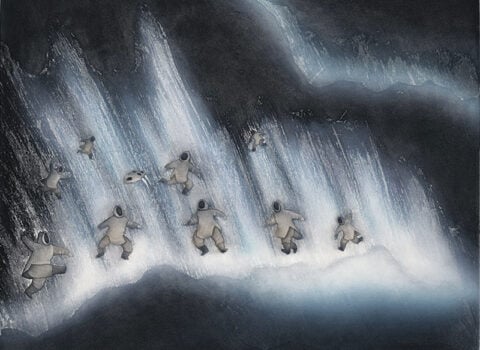On sunny afternoons, many people come to watch sea lions hauled out on the docks at the East Basin Marina in the city of Astoria, on the western tip of Oregon. In the fall, when cruise ships taller than the highest building in town tie up, tourists ride the rattling tram along the waterfront to view the plush, noisy multitude. They like to take selfies next to the sign reading marine mammals are wild animals and can be dangerous! The air on the long breakwater has the rich, organic smell of hundreds of damp animals. The noise is constant, a steady chorus of barking and growling that is audible for blocks. The sea lions lounge and sleep, knock against one another, growl and pose, loll and nip, and slide noiselessly back under the waves. Sea lions will bodysurf in ocean waves and sometimes link into huge, fleshy rafts to drift. When they rest on the water’s surface, you can see one “jugging”—paddling along with one front and one rear flipper out of the water. A mob of sea lions is a mosaic of velvety brown, ever-moving, solid as stone—simultaneously immovable object and irresistible force.
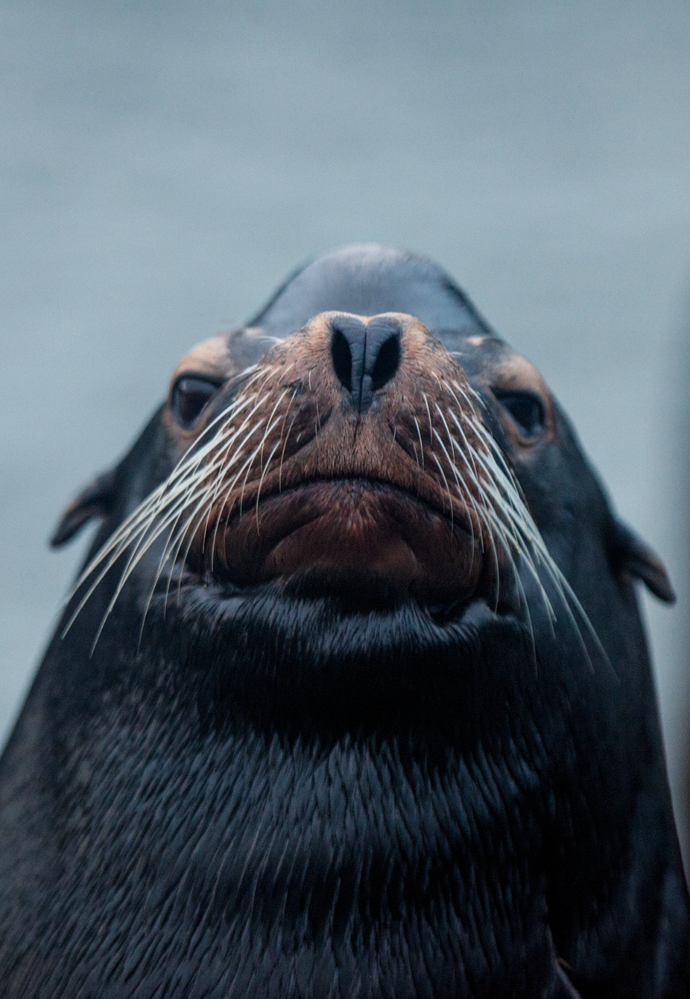
A California sea lion in the East Basin Marina, Astoria, Oregon. All photographs from Oregon, January 2019, by Samuel James for Harper’s Magazine © The artist
Perched in a triangle between river, ocean, and forest, Astoria is the oldest permanent American settlement west of the Rockies. The great Columbia, which begins in Canada, takes in water from seven states, and forms most of the border between Oregon and Washington, exhales here, fanning out with majestic slowness in an estuary almost four miles wide. Cargo ships dot its blue expanse. People have been sustained along this river for more than 11,000 years. It was commonly said of the fish in the Columbia that one could walk across the river on their backs: sturgeon, lamprey, shad, eulachon (a kind of smelt, called ooligan by the tribes), and salmon, perhaps 15 million or more. The salmon ran 13,000 miles of the Columbia River and its countless tributaries, from early spring until late in the fall: Chinook, steelhead, sockeye, pink, coho, and chum. The tribes of the Columbia Plateau traded and intermarried, sharing customs, religious beliefs, and language, through the common wealth of salmon.
In the legend of creation along the river, Salmon was the first gift, the first creature to offer itself to the Creator. As the spring salmon reach each tribe’s traditional fishing area, an important ceremony called the First Salmon Feast is held, to celebrate their return. Before white incursion, Native Americans of the Columbia Plateau ate about a pound of salmon every day; today they eat about ten times as much salmon as the average American. I go upriver to hike, and sometimes I go up to buy salmon. Native fishers set up along the road near Bonneville Dam to sell the morning’s catch out of coolers: whole coho and Chinook, steelhead, even the occasional sturgeon. Jeremy FiveCrows, a Nez Perce who grew up on the reservation in Idaho, works as a public affairs officer for the Columbia River Inter-Tribal Fish Commission (CRITFC), an agency of the four treaty tribes: the Nez Perce Tribe, the Confederated Tribes of the Umatilla Indian Reservation, the Confederated Tribes of the Warm Springs Reservation of Oregon, and the Confederated Tribes and Bands of the Yakama Nation. CRITFC is responsible for the comanagement of all anadromous fish on the river. FiveCrows has a degree in conservation biology from Brigham Young University and speaks Norwegian fluently. “The salmon are the center of the culture of the member tribes. They define our culture,” he says. “That’s where our loyalties lie.”
Astoria was founded just six years after Lewis and Clark traveled much of the lower river to the ocean, in 1805, and the long history of tribal prosperity quickly ended. In 1855, the tribes signed draconian treaties with the United States government, ceding millions of acres of ancestral land. In exchange, they were allowed to continue certain traditions, and most particularly to continue fishing on their ancient grounds. The Nez Perce treaty states,
The exclusive right of taking fish in all the streams where running through or bordering said reservation is further secured to said Indians: as also the right of taking fish at all usual and accustomed places in common with citizens of the territory, and of erecting temporary buildings for curing.
But the first cannery on the river opened in 1866, and many more followed, fed by diabolical fish wheels that scooped millions of pounds of fish a year from the water. The Army Corps of Engineers arrived in the 1860s, too, to dredge a shipping channel and build canals, jetties, and dams.
Today there are eighteen hydroelectric dams on the Columbia River and its main tributary, the Snake River. The most notorious was built near Celilo Falls, once the largest waterfall by volume in North America. Celilo, about 190 miles from the Pacific Ocean, formed a series of long, low plateaus at different heights across a narrow section of the Columbia: wide, ceaseless cascades of hard water that naturally gathered the fish in great pools. Fishing sites at Celilo were passed down for generations, and even after the treaties forced the tribes onto distant reservations, they came to fish here. But when the Dalles Dam just downriver was finished, in 1957, Celilo Falls was drowned. It simply ceased to be. (Several Native fishing villages along the banks were inundated; the government promised to rebuild, but so far has done very little.)*
In 1974, after protracted legal efforts and sometimes violent protests, a US district court in Washington State upheld the treaties of the Columbia Plateau tribes. Known as the Boldt Decision, the ruling upended the fishing industry and still angers non-Indian fishermen. It gave tribal members the right to half of the river’s harvestable fish, and it was upheld by the Supreme Court in 1979. (The number considered harvestable varies. Fishery managers meet throughout the year to set limits that will allow weak populations to rebound and tributary stocks to spawn, but the shares are always kept equal between treaty and non-treaty fishers.) The tribes also have access to thirty-one fishing sites closed to others. A long stretch of the lower river is now divided into six fishing zones. The first five zones are in the 145 miles between the mouth of the Columbia and Bonneville Dam. Zone 6 runs above Bonneville for another 147 miles, and commercial fishing can only be done by the tribes there. The Boldt Decision affirmed the right to fish—but it didn’t bring back the fish. It did nothing to mitigate the desperate losses caused by dams, development, and overfishing. By 1995, there were about 750,000 salmon left in the entire Columbia River.
This kind of devastation is hard to comprehend. How could such infinite bounty come to an end? Numbers continued to fall, despite serious restoration work that began decades ago. In 2008, the Columbia Basin Fish Accords secured $900 million toward repairing habitat. More and better fish ladders, detours that allow fish to pass safely through the dams in ascending pools, were built. A few dams have been removed on tributaries, and efforts to breach more dams continue. The Nez Perce and Yakama tribes have created novel fish hatcheries that mimic natural conditions of camouflage and river flow, to improve smolt survival. Fish runs once extirpated have been restored. But no one is comfortable. Today the river holds about 1.5 million salmon. Barely a fourth are of wild origin, and thirty-two separate stocks are listed as threatened or endangered. Climate change has already caused significant reductions in prey species such as sardines and anchovies, early steps in the collapse of an ecosystem. In September, commercial fisheries for salmon and sardines throughout the West Coast states were granted disaster relief. But over the past ten years, much of the damage has been done by sea lions.
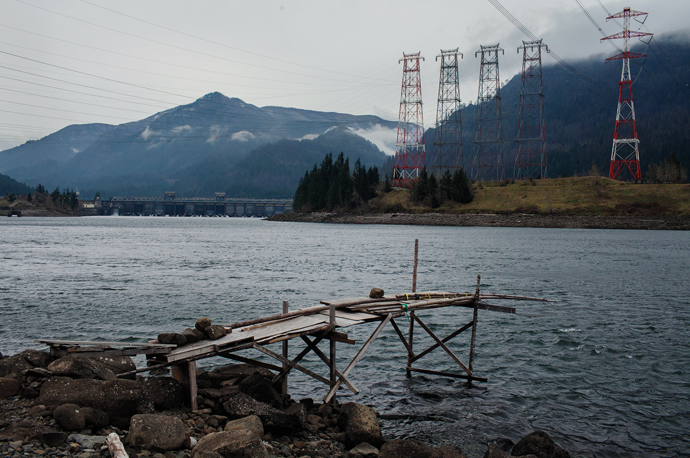
A platform for dipnetting and other traditional fishing methods used by Columbia Plateau tribes, near Bonneville Dam
Sea lions evoke warm feelings in people, the sympathy and kinship many of us have with large, intelligent animals. They have charisma. Astoria has ten thousand people and several thousand sea lions. The animals heave up at East Basin and sprawl across the rocks along the waterfront and under the pubs and coffee shops that have filled the now-defunct canneries. Half the store windows in town display sea lions of one kind or another—stuffed animals, refrigerator magnets, greeting cards. In 1874, the naturalist and whaling captain Charles Scammon wrote a classic work on marine mammals in the Pacific Northwest. He measured his specimens carefully, because “there is a manifest propensity to magnify them until transformed into huge monsters.” These days, we do the opposite—even a two-thousand-pound carnivore seems adorable.
Tourists love the sea lions, and merchants like the tourists. My son is one of the managers of a restaurant in what was once a cannery; a section of the floor is made of glass bricks so that customers can watch the sea lions lolling on the pilings below. Children lie on their bellies and stare at the dozing brown bodies. Every year more than 200,000 people visit Oregon’s enormous Sea Lion Caves on the coast to press against a heavy screen in darkness and watch a large colony of the animals, drinking in the humid perfume of sea lion and sea.
Most of the sea lions in the Columbia River are the familiar California type, common from Alaska to Mexico. They are light-to-dark brown, appear black when wet, and can grow up to eight feet long and weigh nearly nine hundred pounds. (The trained “seals” seen in conventional circuses are usually California sea lions.) They migrate to enormous rookeries in southern California and the coast of Mexico for most of the summer. The larger, paler sea lions wedged among the Californias are Stellers, which breed in the Aleutians and on scattered island rookeries along the Oregon coast. Many Stellers live here year-round. They can grow to eleven feet and weigh a full ton. Virtually all the sea lions seen in the rivers and bays of the West Coast are males; most females stay near the rookeries. Sea lions are considered quite intelligent and quick to learn, with good memories and strong personalities. One biologist I talked to compared a sea lion to a golden retriever; another disagreed, thinking border collie was closer.
The coastal town of Newport, Oregon, has a foundation dedicated to maintaining the docks favored by sea lions, with a viewing platform and a webcam. Like Astoria, Newport is a fishing town transforming itself into a tourist destination, a mélange of big boats, fast-food restaurants, art galleries, beach resorts, and whale-watching tours. The old bayfront is crowded with saltwater-taffy stores, custom T-shirt shops, and rows of noisy taverns across the road from a loud and pungent fish-processing plant. Tourists line the dock to watch the day’s catch unloaded by solemn, tired fishermen and then wander up to the moorings where the sea lions rest.
Newport is also home to the Hatfield Marine Science Center and the Oregon Coast Aquarium. There, beside the aquarium’s pinniped pool, I talked with Brittany Blades, the assistant curator of marine mammals. She is slim, with a blond ponytail and sincere black-framed eyeglasses. The animals were spinning below us, heads breaking the surface for a second or two: a couple of harbor seals; Rosa and Catalina, young female California sea lions; and Max, an adult male. Max was born in a zoo and has been at the aquarium since 1992. Koa, the aquarium’s other male, was recovering from neutering, a complicated operation, and confined to a large pool away from the public. Quill, a twenty-eight-year-old female, lives out of sight of visitors.
When a door clanged, the animals shot out of the water. Two trainers with buckets of fish appeared. Using only positive reinforcement, the keepers at the aquarium have trained the sea lions to allow injections, blood draws, ultrasounds, X-rays, and dental care. Aging sea lions have many of the same health problems we do: arthritis, cataracts, problems with gums and teeth. Quill receives both chiropractic and acupuncture treatments.
The man fed Max a few herring, then noticed Blades and me. For us, he shouted out, “Window,” and Max leaped over the water and landed on the thin ledge beside us, pressing his face against the plexiglass. “Every single animal has its own personality and learning pace,” Blades said. “You have to find what motivates that animal.” I asked her to describe the animals’ personalities. Max is “very easygoing, a handsome old man.” Rosa is “a goofball.” Blades was rueful, hearing her own words. “We try to be as scientific as possible and try not to anthropomorphize them.”
We sat by the window with several entranced visitors of all ages. When the trainer said, “Open!” Max opened wide so that the trainer could examine his teeth. Then he got another herring and sat back on his flippers, waiting. Like a border collie.
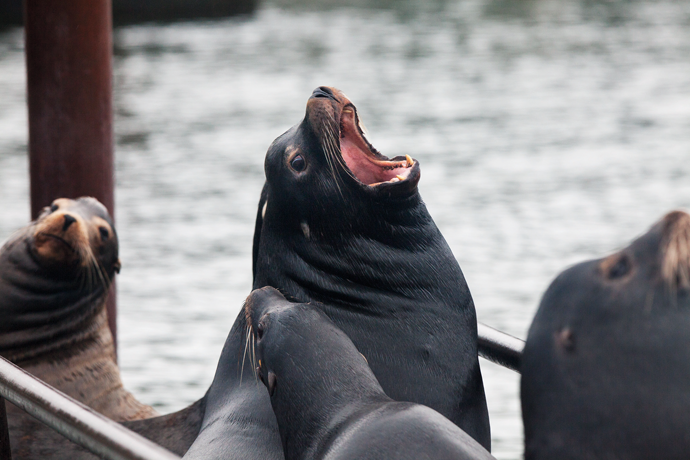
Sea lions on a dock at the East Basin Marina, Astoria
Sea lions almost disappeared into the maw of westward expansion, taken by the tens of thousands for their fur, whiskers, and testicles, which were used for medicine. Scammon described their penchant for living near humans and their “yielding disposition”; it made him wonder whether they were “naturally designed to be slain in numbers equal to the demands of their human pursuers.” By the early 1970s, sea lions were in serious trouble, one reason the Marine Mammal Protection Act was passed in 1972.
The MMPA was the first national law protecting an ecosystem of many species, using the concept of “optimum sustainable populations.” The National Oceanic and Atmospheric Administration (NOAA), through its National Marine Fisheries Service, was given oversight for sea lions. The MMPA prohibits the “taking” of marine mammals, broadly defined as any attempt to harass, hunt, capture, or kill them; their import and export; and the use or trade of their parts or products. The law also mandates research and planning for future conservation. There are several exceptions: “incidental take” in commercial fishing, a certain amount of “authorized take” from construction, military activity, and so on, and a variety of uses for research. Native Alaskans are allowed subsistence use and the use of parts, primarily of whales, for traditional crafts.
Today, the population of California sea lions is around 296,000. The numbers for Stellers are vaguer—they are notoriously difficult to track—but the stock of Steller sea lions in the Pacific Northwest is around 70,000. Many scientists think California sea lions have reached carrying capacity; starvation events in the past few years dropped the number of California sea lions from a high of more than 300,000. Meanwhile, the population of Steller sea lions grows by about 3 percent a year. Their abundance is a kind of miracle, but one with unintended consequences. Doug Hatch is a senior fish scientist for the Columbia River Inter-Tribal Fish Commission. Hatch told me, “One side of the story is that the Marine Mammal Protection Act was extremely successful. Nobody in their wildest idea thought it could be this successful.”
The extraordinary numbers of sea lions have led to new conflicts. Sea lions chase and bite swimmers and have pulled people off boats and docks. In Newport Beach, California, lounging sea lions sank a small yacht. They strip draglines and take fish off hooks and tear open nets. Occasionally, a sea lion will leap into a boat or run onto a beach to steal a fish out of a person’s hands. The East Basin Marina is private property; part of the local commercial fishing fleet ties up here. The sea lions have simply taken it. Their crushing weight is destroying the docks in slow motion, causing more than $100,000 in damage every year. On many days, commercial fishing boats are tied up to a dock thick with the animals. One mammalogist who has had many encounters with sea lions told me, “They’re smart and have the ability to learn, but in the wild, they’re very wild.” I asked a biologist who studies sea lions how a fisherman might get to his boat at East Basin. He has to just walk out there, he said. “They might false-charge you, or they’ll stand up and growl and might come at you a little bit.” He recommended walking “with an assertive posture.”
Certain pods of orcas will eat sea lions but not fish. Other pods eat salmon but not sea lions. A famous resident group of orcas in Puget Sound is close to starvation because of the decline in Chinook salmon. Their plight was a big news story last summer, adding to the growing call to kill sea lions. The governor of Washington, Jay Inslee, has proposed budgeting more than $1 billion to save orcas; about a third of the money will go to salmon recovery and $5 million to find a way of “leveling the playing field” against sea lions, as the governor’s office said in a press release. (In spite of the possibility of large fines and jail time, around seven hundred California sea lions have been killed since 1998. Several have been shot near Astoria. A sudden spike in killings began last September, with eighteen sea lions killed near Seattle—most “assassination-style,” with gunshots to the head; one animal was decapitated.)
Dead sea lions have washed up under the restaurant my son manages, and if you’ve never had to push fifteen hundred pounds of rotting flesh into a river, you may not appreciate the problem. Frustrated people wanting to reclaim the docks have tried throwing beach balls and putting up streamers, plastic fencing, electrified mats, and chicken wire, without result. A life-size plastic orca was met with pinniped disdain, and promptly capsized. Unlike smaller seals, sea lions can rotate their back flippers under themselves to walk on land. Now and then, a sea lion will waddle a block or two into downtown Astoria. There he will sit—on a sidewalk, in the middle of an intersection, anywhere he wants—until he is ready to leave.
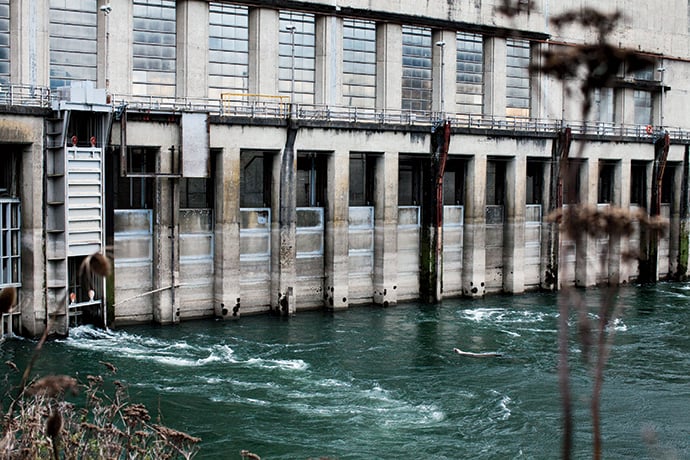
A Steller sea lion hunts for fish at the base of a fish ladder (left) at Bonneville Dam
Sea lions eat what they can easily catch, including many kinds of fish, mollusks, and even the occasional bird. (Scammon described a sea lion hovering underwater with only the tip of its nose showing, as bait for birds.) Salmon can be as much as 30 percent of a sea lion’s natural diet. In the early 1980s, California sea lions found their way to Ballard Locks in Seattle, which connect Puget Sound and Lake Washington. Fish gather near the ladder entrances in big schools. The sea lions had found a feast, and the salmon population quickly fell. For years state workers were allowed to chase, harass, and trap the sea lions. It didn’t work. By the mid-1990s, the Lake Washington winter steelhead run had been essentially destroyed.
California sea lions started climbing the Columbia River in the 1980s as well, traveling 145 miles to Bonneville Dam. They were followed by Steller sea lions more than a decade later. Both species now also travel into tributaries where some of the most important stocks of threatened fish spawn.
The events at Ballard Locks led to an amendment of the MMPA called Section 120, allowing sea lions to be killed under certain conditions. In 2006, the states of Oregon, Washington, and Idaho made a formal request to NOAA under Section 120 to kill a small number of sea lions, calling them a “new, growing, and unmanageable source of mortality” to threatened and endangered fish populations. The requirements of Section 120 were complex and daunting. Any permit request required a public comment period, a task force, and months of deliberation, governed not only by the MMPA but also the Endangered Species Act and the National Environmental Policy Act. After two years of review, in March 2008, NOAA granted a five-year permit to the states to kill sea lions. Very strict limits were imposed. Only California sea lions could be killed. (The agencies involved tend to use the term “removal.”) The sea lions had to be “individually identifiable” and shown to have a “significant negative impact” on a salmonid fishery stock. This impact had to happen above river mile 139 of the Columbia, essentially at Bonneville Dam. The salmonid run had to be listed as threatened or endangered. “Negative impact” meant that a sea lion had to be seen eating a salmonid, and the sea lion had to be sighted on five different days. Then, the animal had to be hazed with “nonlethal alternatives.” Only after an animal was hazed repeatedly and returned to forage could it be killed, and then only between January 1 and May 31. Finally, the total number killed couldn’t exceed 1 percent of the PBR, or potential biological removal—a number that is thought to represent an impact on the reproductive health of the species. The PBR for California sea lions is 9,200. That means the maximum number of animals that could be killed in a year was ninety-two.
In fact, the number killed has been far fewer. The requirements have been hard to meet, time-consuming, and expensive. Several lawsuits have suspended all removals for months at a time. From 2008 to 2017, a total of 168 California sea lions were killed. Seven more died accidentally in traps, which have since been modified. Fifteen sea lions were caught and adopted by zoos and aquariums, all in the first few years of the permit’s implementation. No institution has requested a live sea lion for a long time.
The NOAA permit was extended in 2016 for another five years, with the same requirements. Every person I interviewed for this story could recite parts of the MMPA by rote, and many simply refer to “the 120” in conversation, a shorthand for the complications of their work. Individually identifiable and having a significant negative impact has grown into a kind of chant on the rivers, a catechism of the waters.
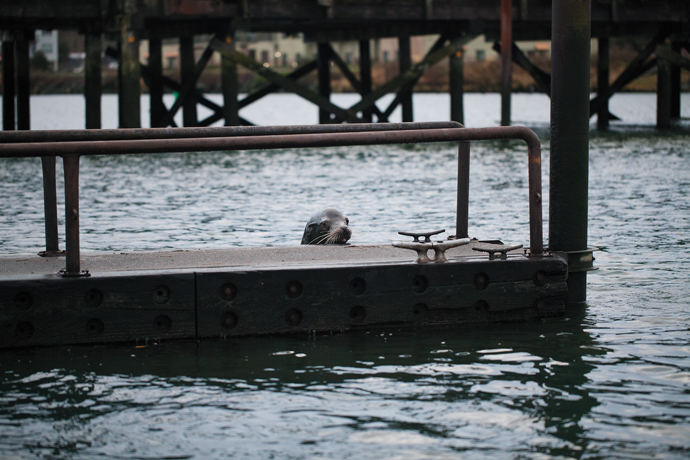
A California sea lion in the East Basin Marina, Astoria
Sea lion management is a complicated dance. NOAA has management authority, through funding, enforcement, and permits. CRITFC and the Army Corps are responsible for research and hazing. The Oregon and Washington Departments of Fish and Wildlife do the actual removals as well as some collaborative research and monitoring. (The United States and Canada share the Columbia River Treaty, governing hydropower and flood control on the 1,200-mile river. The current treaty, implemented in 1964, does not consider the needs of fish or Native American fishing rights, and a new treaty is being negotiated with input from the Columbia Basin tribes.)
Kyle Tidwell leads the pinniped research project at Bonneville, as a citizen employee of the Army Corps. A lean, neat man, Tidwell speaks quietly, in careful, academically precise language. His doctoral work in behavioral ecology was on the impact of American bullfrogs on endangered Oregon spotted frogs; he is at ease with the numbers game of species in conflict.
I met Tidwell by Bonneville Dam on a sunny fall afternoon, under a hazy blue sky. Bonneville is the first dam on the Columbia, a demarcation line between fishing zones, and the first artificial barrier for spawning fish. The complex is visible for miles—two big powerhouses flanking the enormous dam and spillway, the march of gigantic power lines into the hydroelectric grid that feeds the region. Once I had proved that I’m an American citizen, I was given a visitor’s badge and an orange hard hat. Then we drove up to Powerhouse One, the southern section of the dam. Two huge fish ladders girded with thick bars brace the powerhouse. Water pours out beside them, an artificial waterfall to attract the fish. The river directly below is known as the tailrace, a foamy, rough pool filled with mesmerizing ripples. The sea lions that discovered Bonneville quickly learned to go through the fish ladders. The huge grates now in place are called SLEDs—sea lion exclusion devices. When they were added in 2006, a few sea lions learned to go through the locks instead; they jump up on grain barges or swim below boats. For a time, two California sea lions lived above the dam year round, and the Corps keeps the locks closed.
Corps employees spend hours every day on the powerhouse, doing random observations that are noted in huge binders of photos and descriptions, each sea lion identified by color, size, scars, and how it vocalizes. I saw a Corps employee standing by the rail, looking through binoculars. I could see a few dozen fishing boats a mile below; the Chinook and steelhead seasons were still open. “We’re here daily, watching them consume, watching them fish, watching them haul out,” said Tidwell. “We’ve got records that go back on some of these individuals up to twelve years.” A whiteboard near his office lists every known sea lion for the season. Each has an identification number; several of them are followed by a red asterisk, indicating that the animals are to be removed.
About twenty sea lions were at the dam; it was still early in the season. Of the California sea lions in Astoria, about 7 percent will make their way upriver—all males, and fairly young, with an average age of about seven years. (No one knows what percentage of the Stellers come upriver.) We watched two sea lions approach—jugging along, indolent, two pals on their way to work. I could see three more in the distance. In the tailrace, they slid under the small waves, resurfaced elsewhere—diving and chasing fish. A sea lion known locally as Scarface swam directly below us, watching me. Tidwell believes they can tell the difference between a person carrying a notepad and a person carrying a rifle, and that they may recognize the distinct colors of hard hats. Orange hats are usually worn for hazing, and because I was wearing one, I was worth watching.
Oregon and Washington began branding California sea lions in 1997, to help with identification. (Sometimes paint marks are used.) More than 90 percent of the Californias that come to the dam are branded, and the states try to brand every one that arrives. “We know them,” says Tidwell. “They show up in groups, and there’s going to be one or two that are not branded.” These are likely new recruits. Because only California sea lions could be killed, their population is slowly dropping, and the number of Stellers is increasing. “What we see is the Stellers mirroring what the Californias were doing in the early years. In essence, we’ve traded one predator for another.” Traded up: to a bigger, stronger, more aggressive predator that has been completely protected.
This past spring, ninety-eight California sea lions and at least sixty-six Steller sea lions were seen at Bonneville Dam. Often, they were all foraging at once. The sea lions do not always swallow the fish whole; they shake and tear at them, and fishers haul in catch that is torn or injured. Many of the Stellers are staying almost year-round. Individual sea lions trapped at the dam and released on the coast hundreds of miles away have returned in fewer than two days. One sea lion trapped at Ballard Locks in Seattle and driven to San Diego swam back before the truck reached home. Only one in every thirty male sea lions has the chance to breed in the rookeries, and the sea lions that stay near the dam have no chance.
When they first arrived, the Stellers ate large sturgeon—fish that may be eight or ten feet long—but then they started on the salmon and steelhead. The Corps has observed around a hundred sea lions in the tailrace eating more than 2,000 salmon in a single season—another estimate puts the number closer to 13,000. Everyone involved remembers specifics, such as the California sea lion known as C697. He was observed at the pool below the dam for 275 consecutive days. Another California sea lion, C265, was trapped in March 2007, when he weighed 560 pounds. By May, after months of foraging at the dam, he weighed more than 1,000 pounds. FiveCrows says, “By the end, he looked like a giant tick.”
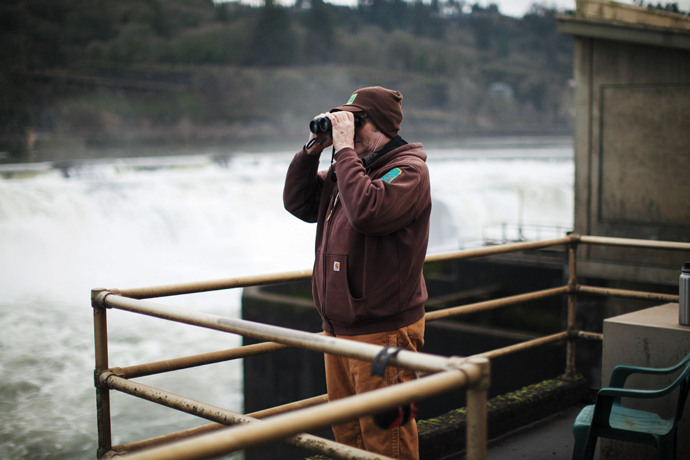
An employee of the Oregon Department of Fish and Wildlife monitors sea lion activity at Willamette Falls
None of this sea lion behavior is exactly natural—that is, sea lions didn’t used to behave this way on the Columbia. They didn’t even come upriver, and there is no historical use of the animal by upper river tribes. (There are remains in coastal middens, where they were likely an occasional food source.) Before they discovered the dams, sea lions would chase spring Chinook into the estuary, then swim up the coast to Puget Sound, and come back to the mouth of the Columbia for fall fish. They worked hard for every pound. As ocean-prey stocks decline and shift with climate change and human pressure, the sea lions have even more motivation to find easier food sources. At Bonneville, Tidwell says, “They’ve found an evolutionary win,” because they get plenty of calories for much less work. Research has found that the behavior of swimming up the river to lodge near the tailrace is passed from animal to animal in the same way a microorganism might pass through a population. Once a lion finds the dam, says Tidwell, “he’s infected with ‘Bonneville.’”
Over the years, everything from recordings of predators to nausea-inducing drugs hidden in fish have been tried to chase the sea lions away. Hazing these days involves cracker shells (explosive shotgun shells), underwater firecrackers called “seal bombs,” and sometimes rubber buckshot. CRITFC has a hazing boat on the water every day from March through May, and the Corps hazes from the top of the powerhouse. Hazing doesn’t work—so I was told, again and again. The animals return to the dam to feed within a few hours. New—“naïve”—individual sea lions may respond to hazing the first few times, leaving the tailrace for a while. But the naïve animal isn’t naïve for long. As Tidwell notes, there is a “cost-benefit ratio that every animal undergoes when it’s looking at a resource.” They learn that hazing doesn’t really hurt. Hazing is done only because the 120 permit requires it.
In a removal, the sea lion is trapped and then put in a transfer cage at the shoreline. That cage is put in a truck and driven to a secure facility, where the animal is moved into a holding cage, and then a squeeze cage—a kind of restraint. The sea lion is given an overdose of anesthesia and then shot in the head with a bolt gun—the two forms of euthanasia dictated by an animal care committee composed of veterinarians and biologists. Tissues are taken for research, and the carcass goes to a rendering plant. The locations and timing are not released.
In 2008, the Humane Society of the United States filed suit to stop the first Section 120 permit that allowed removals, and the suit was joined by two people who said they had personal relationships with individual sea lions at Bonneville. The suit was upheld by the Ninth Circuit Court. Oregon, Washington, and Idaho requested a revised permit, and when this was approved, in 2011, the Humane Society filed suit again, and the states withdrew their permit request. The lawsuit was dropped. Oregon, Washington, and Idaho requested another five-year permit in 2012, and the Humane Society filed suit again but didn’t prevail in court. The multipronged argument against the permit comes down to the idea that sea lions are being made the scapegoat for problems caused by humans: dams, overharvesting, development, and pollution. Sharon Young of the the Humane Society doesn’t believe removals work. “More sea lions will follow,” she says. “It becomes a treadmill of death—you kill one, another one comes.” PETA, the Sea Lion Defense Brigade, Oceana, and other conservation organizations agree. Sea lions, they argue, are being punished for their natural behavior—just for eating—to pay for human folly. Would you kill a horse like that? An elephant or dolphin? A golden retriever? The suit argued that the states and tribes should, instead, work harder on salmon recovery.
When I asked CRITFC’s Doug Hatch about the Humane Society’s position, he gave me a weary look. “We know how many fish cross Bonneville. We know how many fish are in the river. It’s not a guess. And when you add up the predation that’s occurring in that half mile of Bonneville Dam, and you compare that to half a mile anywhere else in the river, there’s no bigger loss.”
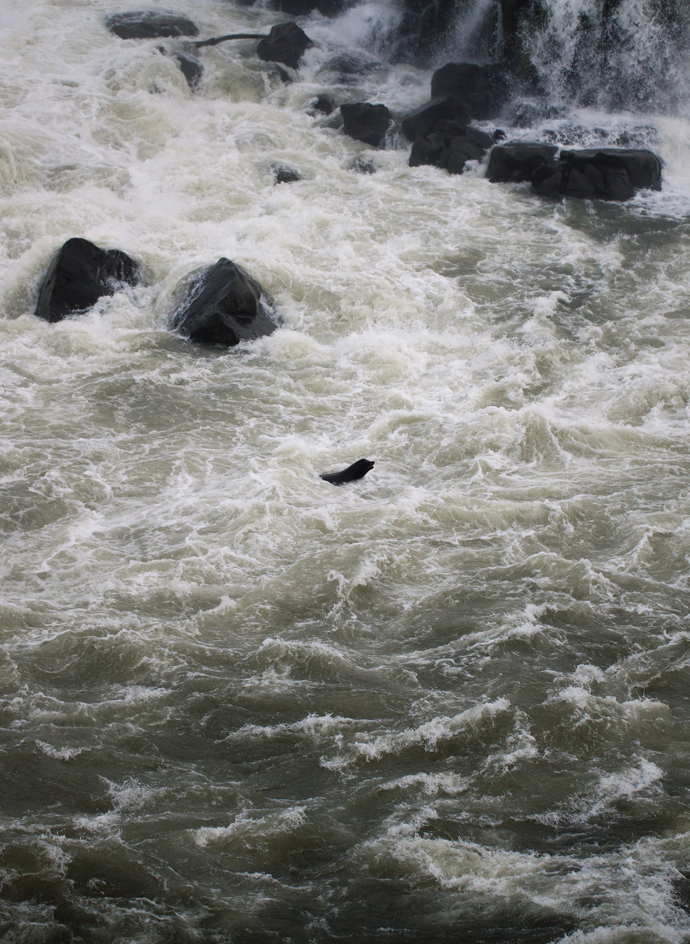
California sea lion at the bottom of Willamette Falls
More than twenty years ago, sea lions discovered Willamette Falls, an enormous basalt cascade in the shape of a horseshoe on the Willamette River. Willamette Falls is the second most powerful waterfall in the United States. Its huge flow has been used for power and manufacturing since the 1850s, and today the waterfall is modified with various walls, grates, turbines, and fish ladders. The Willamette runs twenty-seven miles beyond the falls, bisecting Portland before it enters the Columbia. Long runs of fall and spring Chinook, coho salmon, and winter steelhead cross the falls to spawn in its tributaries.
At first, a few California sea lions would arrive in April and leave in May; last year, they returned in August. At least two have been living at Willamette Falls for a decade, and as many as ten Steller sea lions have joined them. Altogether, somewhere between fifty and a hundred sea lions spend the spring there. They feed in the natural pools below the falls and in the rough tailrace below the power plant, where long chutes bring the salmon safely past the turbines. In the early 2000s, around twenty thousand winter steelhead crossed the falls yearly; the run was doing so well that biologists began to wonder whether it could be “delisted”—taken off the threatened list. But the fish began to disappear, and in 2017 only 512 steelhead made the trip. Sea lions now eat about 22 percent of the winter steelhead and almost 10 percent of spring Chinook, along with significant quantities of lamprey and coho. (Eulachon and lamprey are also important species, but they rarely are mentioned in the public conversation.)
Up until last November, when a new permit for Willamette Falls was approved, no sea lions could be killed there. Dr. Shaun Clements, a fisheries biologist with the Oregon Department of Fish and Wildlife who monitors the situation at Willamette Falls, thinks new lawsuits would be dismissed quickly, because the data is so convincing. Like everyone else concerned, Clements knows that there are global ecological changes at work, that humans are the biggest problem. He told me, “It’s not like we’re walking away from all that recovery work and saying, ‘Let’s just kill sea lions.’ We can’t ignore a twenty- or twenty-five-percent loss of fish. There’s no sign that it will get better on its own. And if we do nothing, we’ll lose fish runs.” He uses the analogy of a person with a terminal illness who is bleeding from the femoral artery. “You don’t ignore the artery,” he said. “You fix it while you’re still treating the disease.”
And yet. At the aquarium, watching Max and Rosa and Catalina, Brittany Blades told me she wishes the problem sea lions could all be adopted, knowing this is unrealistic. Blades once worked at the Oregon Zoo with Steller sea lions; when the animals died of old age, the exhibit closed. The aquarium won’t take Stellers because they are too big and difficult to manage. Blades knows there is no way to get several hundred sea lions adopted. So she’s thought about how to use positive conditioning to move the sea lions away from the dams—but what better positive conditioning is there than a giant salmon buffet? She shook her head, watching Max, troubled. “I can’t imagine anyone killing a healthy sea lion.”
Jeremy FiveCrows told me that sea lions have interfered with the First Salmon ceremony. He says the tribes care most about restoring the balance between sea lions and salmon. “We’re protecting our First Food. And it is an interesting juxtaposition. Here we have an intimate spiritual connection with this animal, and it’s being weighed against an animal we don’t have an intimate spiritual connection to.” But the tribes would use the sea lion carcasses if they could, for the bones and hides. (The flesh is not edible, because it is toxic from accumulated heavy metals, as with many apex predators.) The Marine Mammal Protection Act forbids any use. “It makes it even harder for people to swallow,” FiveCrows told me. Sea lions aren’t harvested, the way overpopulating deer can be. “They’re not killed and used in any way. They’re just killed.”
I asked Tidwell how he felt when a familiar sea lion was killed. “None of us are here to kill these animals. None of us signed up to be sea lion slaughterers. We’re here because we care for the resource.” He gives me a rare smile. “Luckily, we’re all population biologists up here.”
CRITFC’s Doug Hatch had told me the same thing. “That’s what we do—we manage renewable natural populations. And from the population level, removing hundreds of sea lions from the Columbia River has zero impact on the population. Those individuals, their number was up, but that’s not what we manage. We don’t manage individual fish—we manage fish populations. And we have to do the same thing with elk and deer and sea lions, the same way. Removing those animals can have zero impact on their biology, but it can have a huge positive effect for the salmon, and they’re in a much worse status. That’s where we fall.”
I asked Hatch what he would do if there were no MMPA. He leaned forward. “I’d draw a line. I’d draw a line in the river, probably below Rainier, and say, ‘We’re not going to allow sea lions above this line.’ And they would learn, very quickly, that that’s not the place to be. It would end up only taking a few hundred sea lions, and that’s the first year. After that, it’s fewer, because then you don’t have any individual that’s habituated there. It’s all new explorers, and those are always fewer.” He sat back. “It would be bloody, to start with.”
He will get his wish, more or less. Just before Christmas, the Marine Mammal Protection Act was amended—Section 120, specifically. The Endangered Salmon Predation Protection Act had bipartisan support, including from the entire congressional delegations and the governors of Oregon, Washington, and Idaho. The new law allows the states of Oregon, Washington, and Idaho and the four treaty tribes to apply for five-year permits to kill sea lions on the Columbia and its tributaries as well as on the Willamette River. The take can be 10 percent of the potential biological removal, the PBR—ten times more than the 120 permits had allowed. The bill also removes most of the remaining 120 requirements. No more monitoring and tracking every mark and scar. No more trapping or hazing. Any sea lion found past mile 112 of the Columbia—near a bridge connecting Portland and Vancouver, Washington—and in any tributary with spawning habitat for threatened fish can be removed. This includes Steller sea lions. The bill states that any sea lion found this far upriver “is deemed to be individually identifiable . . . [and] deemed to be having a significant negative impact.”

A California sea lion in the East Basin Marina, Astoria
I still like to watch the sea lions under the brewery and at East Basin. They are endlessly amusing—so confident, at ease in their superiority. The Columbia is massive, and the sea lions feel at home there. I watch happy people taking happy photographs, showing their children the miracle of an endangered species pulled back from the brink.
But I also have a cabin on one of the small tributaries of the Columbia about an hour east of Portland. It’s a narrow, fast, and shallow river, cold as the snow that feeds it. About ten years ago, a dam was removed from a lower river, and a few years later, I saw salmon spawning in the waters next to my cabin: big, muscular, dying salmon thrashing the gravel under the tall fir trees, shaded by thimbleberry and moss, home at last. Sometimes I stand on the riverbanks near my cabin and imagine a sea lion looking back at me. What would I feel? Wonder, I’m sure—but finding a sea lion far from the sea is mostly weird. It’s easy to pretend this is a virgin river, that the forest around me is natural, that things are as they have always been. But I know better. I know how damaged these rivers are, how far from what they were a few hundred years ago. We toppled the balance of this entirely wild place, this planet, so quickly. The orcas and sea lions are victims of our greed as much as the fish, and now we’re left with a Hobson’s choice. When I encounter sea lions high upriver, more than anything I grieve over how much has gone wrong.


